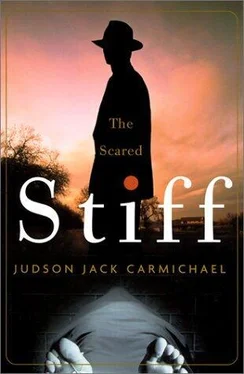“No, no,” he said. “She’s his niece. Carlos, he’s her uncle, he wouldn’t do a thing like that.”
“Oh,” I said.
We walked some more, and I became aware that Arturo was watching me, with that overly boyish grin of his. I said, “What now?”
“Don’t go get yourself in trouble, hermano,” he said. “You know what I mean.”
I looked at him. “What, me? You don’t have to worry about me.”
Friday was the day: Two days after my meeting with Cousin Carlos, almost a week after our arrival in Guerrera, and the beginning of the weekend. What better time for it? And what better place than Vista Alegar, the closest thing Guerrera has to a tourist attraction?
At 837 feet, Vista Alegar is the highest spot in Guerrera, up in the mountains along the southern border with Brazil. As the crow flies, it’s probably sixty miles from Sabanon down to the border, but roads are few in Guerrera and meandering, mostly following the rivers and circling around mountains, so it can take nearly three hours to make the trip.
The last several miles, one drives due south but steeply uphill, beside a narrow rocky tumbling northbound river called the Conoro. As the road climbs, the descending river becomes more and more agitated, till there are actual rapids, visible from the road, and swirling deep pools that the more adventurous tourists swim in, and even brief noisy white waterfalls. Vines dangle down over all, and there’s huge-fronded and huge-leaved jungle growth and incredibly gaudy birds flickering here and there, occasionally making sounds like a Marine Corps drill instructor.
For the last few miles to the border and the town of Vista Alegar, the road veers away from the river, and soon there are dirt roads angling off leftward toward tourist spots constructed along the steep banks. Most of these turnoffs are marked by rough-and-ready signs painted on or carved into wooden planks. The one we wanted had two such signs: GLOBAL WARMING CAMP and THE SCARLET TOUCAN, that being the restaurant we were headed for.
We turned in there and jounced over the roots and stones and brick-hard ruts of the narrow tan road through the jungle, the Beetle bounding around like a Christmas ornament in a hurricane and the both of us holding on for dear life, me to the steering wheel, Lola to whatever she could find. Twilight came more rapidly in the jungle, and I had to stop at one point to find the headlights.
Soon those lights picked out another car ahead of us, going the same way, even more slowly; a bright red Honda Accord with a rental company sticker on its bumper. “Not our undertaker,” I said, “but he drives like an undertaker.”
“He’s an undertaker in northern Michigan,” Lola decided. “Here he’s just a guy afraid of potholes.”
The Scarlet Toucan’s parking lot is gravel, a broad, more or less flat area to the left of the restaurant, with a flimsy rail fence marking the edge of the dropoff to the river below. The lot is lit at night by kerosene-burning torches spaced around the perimeter, but that glow is nothing compared to the electric floodlights under the restaurant itself, which is cantilevered out over the cliff. All that light makes the river and its rocks and the surrounding jungle brighter and harsher and seemingly closer than by day.
While the cautious driver of the Accord angled off to find a spot as close to the restaurant entrance as possible, among the ten or twelve cars already parked there, I steered the other way, to the nearest free spot along the fence. I parked with the Beetle’s nose not quite touching the rail, and when I got out I could look down at the sharply lit picture of the rapids. I could hear them, too, rushing and shushing down there.
Not speaking, holding each other’s arms, we walked toward the restaurant. I could feel Lola’s tension trembling in her arm, and I suppose she could feel mine as well.
The Scarlet Toucan, like most interesting restaurants in really obscure out-of-the-way places around the world, was owned, or at least operated, by a New Yorker who’d decided to get away from town for a few years. This particular Rick, whose name was Mike, was a wiry sharp-featured guy of indeterminate age and a deep tan and black hair flat on a stony skull. He’s aggressively friendly without content, but that’s okay; the food’s good.
The restaurant seems rickety and probably is, but it’s stood this long and might stand awhile longer, so why worry? There isn’t much by way of building codes out here in the jungle, so what you have to rely on mostly is Mike’s self-interest. If the restaurant someday were to fall into the rocky river below — way below — we might or might not be here that day, but Mike certainly would. So it’s his confidence in the joint’s stability we’re relying on, and let’s hope he’s right.
The restaurant is bamboo-walled, with a conical thatch roof, like a coolie’s hat. The interior is dark, mostly, except at the far end, facing the view. The mahogany tables and chairs are clunky but comfortable local workmanship. The decor makes me think of the South Seas, but I guess it’s just supposed to be generic expatriate.
While waiting for Mike to come deal with us, I glanced at the other diners here, a mix of tourists and well-off locals, and tried not to guess which one would be my undertaker. I had deliberately avoided meeting the man, leaving all that part to Arturo. He would be here, that’s all, having a nice meal at my expense, ready to do his thing when the time came.
Now Mike did come over, to shake our hands and introduce himself — we’d met him before, of course — and gush over us and say, “You folks having a great time?”
“Great,” I agreed. I was a little drunk, just enough to be noticeable. “Even the wife is loosening up,” I said, “and that’s saying a lot.”
Lola glowered at me but kept silent. Mike turned swiftly to his registration book. “Lemme see, lemme see: Lee. You requested a table by the view.”
“I’m about ready for a view,” I said.
Not looking at us, he reached for two menus and a wine list. “Come this way.”
Lola and I both decided to follow him first, so we bumped into each other. She glared at me, while Mike tried not to notice, and I did an elaborate satiric bow, saying, “After you, your Majesty.”
“A gentleman,” she commented caustically, and we followed Mike out to the view, which is to say, out to the far edge of the plank platform the Scarlet Toucan is built on. Out there, where the floor stops, there’s a rough wooden railing at waist height, but that’s all. Nothing else: no glass, no screens, nothing. When you sit at a table along this edge, you lo\ok down past your thigh at white water and black boulders way down there.
“Enjoy your meal,” Mike told us before he left, but his heart didn’t seem to be in it. And we sat there, me particularly resplendent in all that light in a royal-blue shirt, worn especially for the occasion.
Our waitress arrived a minute later. A nice slender convent-bred local girl with a sweet smile, she was difficult to be rude to, but I did my best. When she stopped beside our table, before she could ask a single question or even wish us a good evening, I fixed a slightly drunken stare on her and demanded, “Do you know what Tanqueray gin is?”
“Oh, yes, sir, would you—”
“I mean Tanqueray,” I interrupted. “I don’t mean booga-booga or some other local crap, I mean Tanqueray. You know what that is.”
“Yes, sir,” she assured me, her smile only slightly dimmed. “It is in a green bottle. Our barten—”
To Lola, with elaborate astonishment, I exclaimed, “A green bottle! How do you like that? It’s in a green bottle! Civilization has come to wherever the fuck we are.”
Читать дальше












